Valorisation of Forest Waste into Natural Textile Dyes—Case Study of Pine Cones
Abstract
:1. Introduction
2. Materials and Methods
2.1. Dye Extraction
2.2. Dye Characterisation
2.3. Dyeing Test
2.4. Quality Control of the Dyeing Process
2.5. Colour Fastness to Light and Water
3. Results
3.1. Pine Cone Extract Analysis
3.2. Materials Characterisation by FTIR
3.2.1. FTIR Analysis of the Original Pine Co006Ee and the Extracted Pine Cone
3.2.2. FTIR Comparative Analysis of the Three Extracts (1%, 5% and 10% NaOH)
3.3. Cotton Dyeing Test
3.4. Colour Fastness Test to Light
3.5. Colour Fastness Test to Water
4. Conclusions
Author Contributions
Funding
Data Availability Statement
Acknowledgments
Conflicts of Interest
Abbreviations
| pH | Potential of hydrogen |
| K | Absorption |
| S | Scattering |
| DPPH | 2,2-diphenyl-1-picrylhydrazyl |
| NaOH | Sodium hydroxide |
| FTIR | Fourier-transform infrared spectroscopy |
| R | Reflectance |
| TS | Solid content |
| Ta | the moisture content |
| Ved | volume of diluted extract |
| Ve | extract volume |
| Cag | concentration of gallic acid |
References
- 6º Inventário Florestal Nacional (IFN6). Available online: https://www.icnf.pt/api/file/doc/0f0165f9df0d0bbe (accessed on 24 October 2024).
- Avillez, F.; Martinho, S.; Campello, F.; Serrano, P.; Gamito, T.; Aires, N.; Lopes, R.; Brás, S. Linhas Estratégicas dos Setores de Produção Primária no Contexto do Desenvolvimento da Estratégia Nacional para a Bioeconomia Sustentável 2030: Relatório Principal; Gabinete de Planeamento, Políticas e Administração Geral (GPP): Lisboa, Portugal, 2021; Available online: https://www.gpp.pt/ (accessed on 24 October 2024).
- Kreye, J.K.; Varner, J.M.; Dugaw, C.J.; Cao, J.; Szecsei, J.; Engber, E.A. Pine Cones Facilitate Ignition of Forest Floor Duff. Can. J. For. Res 2013, 43, 512–516. [Google Scholar] [CrossRef]
- Borges, C.H.A.; Souto, P.C.; Neto, J.H.d.N.; Souto, J.S.; Araujo, E.C.G.; Silva, T.C. Combustibility of fuel material for forest species. Sci. Electron. Arch. 2021, 14, 14–17. [Google Scholar] [CrossRef]
- Silva, F.C.; Santos, M.; Moura, J.; Boas, A.C.V.; Matos, M.A.; Tarelho, L.A.C. Preventing Wildfires through Smart Management and Valorisation of Residual Forest Biomass into Biochar: Experiences from the BioValChar Project. In Proceedings of the IX International Conference on Forest Fire Research, Coimbra, Portugal, 11–18 November 2022; pp. 1507–1512. [Google Scholar] [CrossRef]
- Lima, E.C.; Royer, B.; Vaghetti, J.C.P.; Brasil, J.L.; Simon, N.M.; dos Santos, A.A.; Pavan, F.A.; Dias, S.L.P.; Benvenutti, E.V.; da Silva, E.A. Adsorption of Cu (II) on Araucaria angustifolia Wastes: Determination of the Optimal Conditions by Statistic Design of Experiments. J. Hazard. Mater. 2007, 140, 211–220. [Google Scholar] [CrossRef] [PubMed]
- Rezende, S.C.d. Valorisation of Pine Nut Bark, a by-Product of the Araucaria angustifolia Seed, for the Production of Polymeric Materials. Bachelor’s Thesis, Federal Technological University of Paraná, Bragança, Portugal, 2016. [Google Scholar]
- Kumar, A.; Gupta, V.; Gaikwad, K.K. Microfibrillated Cellulose from Pine Cone: Extraction, Properties, and Characterization. Biomass Conv. Bioref. 2023, 13, 1–8. [Google Scholar] [CrossRef]
- Feng, S.; Cheng, S.; Yuan, Z.; Leitch, M.; Xu, C. Valorization of Bark for Chemicals and Materials: A Review. Renew. Sustain. Energy Rev. 2013, 26, 560–578. [Google Scholar] [CrossRef]
- Martínez, J. Caracterización del Rendimiento y Propiedades Físicas de la Piña y el Piñón; Jornadas Técnicas de Frutos Secos: Madrid, Spain, 2008. [Google Scholar]
- Manshoven, S.; Christis, M.; Vercalsteren, A.; Arnold, M.; Nicolau, M.; Lafond, E. Textiles and the Environment in a Circular Economy; European Topic Centre on Waste and Materials in a Green Economy: Mol, Belgium, 2019; Available online: https://www.eea.europa.eu/en/analysis/publications/textiles-in-europes-circular-economy (accessed on 20 January 2025).
- Hoque, M.B.; Oyshi, T.H.; Hannan, M.A.; Haque, P.; Rahman, M.M.; Shahid, M.A.; Sheikh, S. Unraveling the Ecological Footprint of Textile Dyes: A Growing Environmental Concern. Pollut. Stud. 2024, 5, 3014. [Google Scholar] [CrossRef]
- Shams, T.; Ruma, N.J.; Basit, A. Assessing the Financial and Environmental Impact of Natural Dyes and Mordants: ROI and Sustainability Metrics in Sonication-Assisted Dyeing. Res. J. Sci. Technol. 2024, 12, 124–135. [Google Scholar] [CrossRef]
- Patil, S.; Athalye, A. Sustainable Coloration Technologies. Dep. Fibers Text. Process. Technol. 2024, 4, 1–8. [Google Scholar] [CrossRef]
- Adeel, S.; Ahmad, S.; Habib, N.; Saif, M.J.; Batool, F.; Aftab, M. Environmental friendly pollution free bio-dyeing of wool with haar singhar (Coral Jasmine) flower extract. Environ. Sci. Pollut. Res. 2023, 30, 12453–12465. [Google Scholar] [CrossRef]
- Habib, N.; Batool, F.; Adeel, S.; Naveed, M.; Ali, A.; Mia, R.; Assiri, M.A. Green extraction and application of yellow natural curcumin colorant from Curcuma aromatica rhizomes for silk dyeing. Sci. Rep. 2024, 14, 13032. [Google Scholar] [CrossRef]
- Yusuf, M.; Shabbir, M.; Mohammad, F. Natural Colorants: Historical, Processing and Sustainable Prospects. Nat. Prod. Bioprospect. 2017, 7, 123–145. [Google Scholar] [CrossRef] [PubMed]
- Pizzi, A. Tannins: Prospectives and Actual Industrial Applications. Biomolecules 2019, 9, 344. [Google Scholar] [CrossRef]
- Araújo, M.E.M.D. Natural dyestuffs from Antiquity to modern days. Cons. Património 2006, 3–4, 39–51. [Google Scholar] [CrossRef]
- Lopes, A.F.F. The Economic Value of Portuguese Pine and Eucalyptus Forests. Master’s Thesis, NOVA—School of Business and Economics, Lisboa, Portugal, 2013. [Google Scholar]
- Santos, A.; Simões, R.; Pereira, H.; Anjos, O. Alternative Species for the Forest Industry as Forms of Diversify the Landscape; II Simposio Iberoamericano de Gestión y Economía Forestal: Barcelona, Spain, 2004. [Google Scholar]
- Muhamad, I.I.; Hassan, N.D.; Mamat, S.N.H.; Nawi, N.M.; Rashid, W.A.; Tan, N.A. Extraction Technologies and Solvents of Phytocompounds from Plant Materials: Physicochemical Characterization and Identification of Ingredients and Bioactive Compounds from Plant Extract Using Various Instrumentations. In Ingredients Extraction by Physicochemical Methods in Food; Grumezescu, A.M., Holban, A.M., Eds.; Handbook of Food Bioengineering; Academic Press: Cambridge, MA, USA, 2017; pp. 523–560. [Google Scholar] [CrossRef]
- Shahidi, F.; Ambigaipalan, P. Phenolics and Polyphenolics in Foods, Beverages and Spices: Antioxidant Activity and Health Effects—A Review. J. Funct. Foods 2015, 18, 820–897. [Google Scholar] [CrossRef]
- Guyot, S.; Marnet, N.; Laraba, D.; Sanoner, P.; Drilleau, J.-F. Reversed-Phase HPLC Following Thiolysis for Quantitative Estimation and Characterization of the Four Main Classes of Phenolic Compounds in Different Tissue Zones of a French Cider Apple Variety (Malus domestica Var. Kermerrien). J. Agric. Food Chem. 1998, 46, 1698–1705. [Google Scholar] [CrossRef]
- Alves, C.Q.; David, J.M.; David, J.P.; Bahia, M.V.; Aguiar, R.M. Methods for determination of in vitro antioxidant activity for extracts and organic compounds. Quím. Nova 2010, 33, 2202–2210. [Google Scholar] [CrossRef]
- Product COTOBLANC STM—CHT Group—Special Chemicals. Available online: https://solutions.cht.com (accessed on 25 October 2024).
- Ghanean, S.; Afjeh, M.G. Application of Derivative Spectrophotometry to Determine the Relation Between Color Intensity and Dye Concentration of Madder. Prog. Color Color. Coat. 2016, 9, 183–194. [Google Scholar] [CrossRef]
- ISO 105-A05:1996; Textiles—Tests for Colour Fastness—Part A05: Instrumental Assessment of Change in Colour for Determination of Grey Scale Rating. International Organization for Standardization (ISO): Geneva, Switzerland, 1996.
- ISO 105-B02:2014; Textiles—Tests for Colour Fastness—Part B02: Colour Fastness to Artificial Light: Xenon Arc Fading Lamp Test. International Organization for Standardization (ISO): Geneva, Switzerland, 2014.
- ISO 105-E01:2013; Textiles—Tests for Colour Fastness—Part E01: Colour Fastness to Water. International Organization for Standardization (ISO): Geneva, Switzerland, 2013.
- Cheng, T.-H.; Liu, Z.-J.; Yang, J.-Y.; Huang, Y.-Z.; Tang, R.-C.; Qiao, Y.-F. Extraction of Functional Dyes from Tea Stem Waste in Alkaline Medium and Their Application for Simultaneous Coloration and Flame Retardant and Bioactive Functionalization of Silk. ACS Sustain. Chem. Eng. 2019, 7, 18405–18413. [Google Scholar] [CrossRef]
- Lv, S.; Lin, X.; Gao, Z.; Hou, X.; Zhou, H.; Sun, J. Phenol Liquefaction of Waste Sawdust Pretreated by Sodium Hydroxide: Optimization of Parameters Using Response Surface Methodology. Molecules 2022, 27, 7880. [Google Scholar] [CrossRef]
- Jurasekova, Z.; Domingo, C.; Garcia-Ramos, J.V.; Sanchez-Cortes, S. Effect of pH on the Chemical Modification of Quercetin and Structurally Related Flavonoids Characterized by Optical (UV-Visible and Raman) Spectroscopy. Phys. Chem. Chem. Phys. 2014, 16, 12802–12811. [Google Scholar] [CrossRef]
- Cordenunsi, B.R.; Oliveira do Nascimento, J.R.; Genovese, M.I.; Lajolo, F.M. Influence of Cultivar on Quality Parameters and Chemical Composition of Strawberry Fruits Grown in Brazil. J. Agric. Food Chem. 2002, 50, 2581–2586. [Google Scholar] [CrossRef] [PubMed]
- Weigl-Kuska, M.; Kandelbauer, A.; Hansmann, C.; Pöckl, J.; Müller, U.; Grabner, M. Application of Natural Dyes in the Coloration of Wood. In Handbook of Natural Colorants; Bechtold, T., Mussak, R., Eds.; Wiley: Chichester, UK, 2009; pp. 278–313. [Google Scholar] [CrossRef]
- Pereira Filho, J.M.; Vieira, E.d.L.; Silva, A.M.d.A.; Cezar, M.F.; Amorim, F.U. Effect of sodium hydroxide treatment on fiber fraction, digestibility and tannin of jurema-preta hay (Mimosa tenuiflora. Wild) R. Bras. Zootec. 2003, 32, 70–76. [Google Scholar] [CrossRef]
- Ribeiro, L.F. Avaliação dos Compostos Bioativos e Atividade Antioxidante In Vitro e In Vivo em Bagaços de Uvas (Vitis vinifera e Vitis labrusca). Master’s Thesis, Universidade Federal do Paraná, Paraná, Brazil, 2016. [Google Scholar]
- Rockenbach, I.I.; Rodrigues, E.; Gonzaga, L.V.; Caliari, V.; Genovese, M.I.; Gonçalves, A.E.S.S.; Fett, R. Phenolic Compounds Content and Antioxidant Activity in Pomace from Selected Red Grapes (Vitis vinifera L. and Vitis labrusca L.) Widely Produced in Brazil. Food Chem. 2011, 127, 174–179. [Google Scholar] [CrossRef]
- Silva, M.L.C.; Costa, R.S.; Santana, A.D.S.; Koblitz, M.G.B. Phenolic compounds, carotenoids and antioxidant activity in plant products. Semin. Ciências Agrárias 2010, 31, 669. [Google Scholar] [CrossRef]
- Fernandes, C.V.; Queiroz, C.R.A.S.A.; Almeida, E.S.; Melo, C.M.T. Phenolic content and antioxidant activity of medicinal plants. Res. Soc. Dev. 2023, 12, e16212340475. [Google Scholar] [CrossRef]
- Nimya, K.P.; Rani, M.A.S.; Felix, D.M.J. Isolation, Extraction, Antioxidant Activity and Standardization of Natural Dyes from Bixa orellana L. Seeds and the Leaves of Lawsonia inermis L. Int. J. Pharm. Sci. Res. 2021, 12, 2500–2507. [Google Scholar] [CrossRef]
- Rani, D.J. Antioxidant Activity and Phytochemical Composition of the Selected Fruits; IGI Global: Hershey, PA, USA, 2024; pp. 1–19. [Google Scholar] [CrossRef]
- Arvanitoyannis, I.; Ladas, D.; Mavromatis, A. Potential Uses and Applications of Treated Wine Waste: A Review. International J. Food Sci. Technol. 2006, 41, 475–487. [Google Scholar] [CrossRef]
- Lopes, W.A.; Fascio, M. Flow chart for infrared spectra interpretation of organic compounds. Quím. Nova 2004, 27, 670–673. [Google Scholar] [CrossRef]
- Xu, J.-D.; Li, M.-F.; Sun, R.-C. Successive Fractionations of Hemicelluloses and Lignin from Sorghum Stem by Sodium Hydroxide Aqueous Solutions with Increased Concentrations. Bioresources 2018, 13, 2356–2373. [Google Scholar] [CrossRef]
- Gong, Y.; Chen, X.; Wu, W. Application of Fourier Transform Infrared (FTIR) Spectroscopy in Sample Preparation: Material Characterization and Mechanism Investigation. Adv. Sample Prep. 2024, 11, 100122. [Google Scholar] [CrossRef]
- Stuart, B. Infrared Spectroscopy: Fundamentals and Applications; Wiley: Chichester, UK; Hoboken, NJ, USA, 2004. [Google Scholar]
- Barraza-Garza, G.; Castillo-Michel, H.; de la Rosa, L.A.; Martinez-Martinez, A.; Pérez-León, J.A.; Cotte, M.; Alvarez-Parrilla, E. Infrared Spectroscopy as a Tool to Study the Antioxidant Activity of Polyphenolic Compounds in Isolated Rat Enterocytes. Oxid. Med. Cell. Longev. 2016, 2016, 9245150. [Google Scholar] [CrossRef] [PubMed]
- Colthup, N.B.; Daly, L.H.; Wiberley, S.E. Introduction to Infrared and Raman Spectroscopy; Academic Press: Nova Iorque, NY, USA, 1990. [Google Scholar]
- Jovanović, D.; Jokanović, M.; Petrović, L.; Jovančić, P.; Uskoković, D. Structural Characterization of Cotton Fibres Modified by Colloidal Nanosilver. Tekst. Ind. 2020, 68, 12–18. [Google Scholar] [CrossRef]
- Chatlopadhyay, D.P. Cationization of Cotton for Low-Salt or Salt-Free Dyeing. Indian J. Fibre Text. Res. 2001, 26, 108–115. [Google Scholar]
- Jadhav, A.S. Flavonoids and Fruit Coloration: A Comprehensive Review of Biochemical Pathway and Environmental Interactions. Int. J. Sci. Technol. Eng. 2024, 12, 1027–1033. [Google Scholar] [CrossRef]
- Goltz, D.; Ahmadi, S.; Crawford, J.; Craig, D. Photochemical Properties of Selected Flavonol Dyes: Effects on Their Separation Using Capillary Electrophoresis. J. Liq. Chromatogr. Relat. Technol. 2016, 39, 768–774. [Google Scholar] [CrossRef]
- Coscieme, L.; Manshoven, S.; Gillabel, J.; Grossi, F.; Mortensen, L.F. A Framework of Circular Business Models for Fashion and Textiles: The Role of Business-Model, Technical, and Social Innovation. Sustain. Sci. Pract. Policy 2022, 18, 451–462. [Google Scholar] [CrossRef]
- Samanta, A.K. Colorimetry; BoD—Books on Demand: Norderstedt, Germany, 2022. [Google Scholar]
- Comissão Internacional de Iluminação (CIE)—Conselho Internacional de Ciência. International Science Council. Available online: https://pt.council.science/member/cie-commission-internationale-de-leclairage/ (accessed on 25 October 2024).
- Clark, M. Handbook of Textile and Industrial Dyeing: Principles, Processes and Types of Dyes; Elsevier: Amsterdam, The Netherlands, 2011. [Google Scholar]
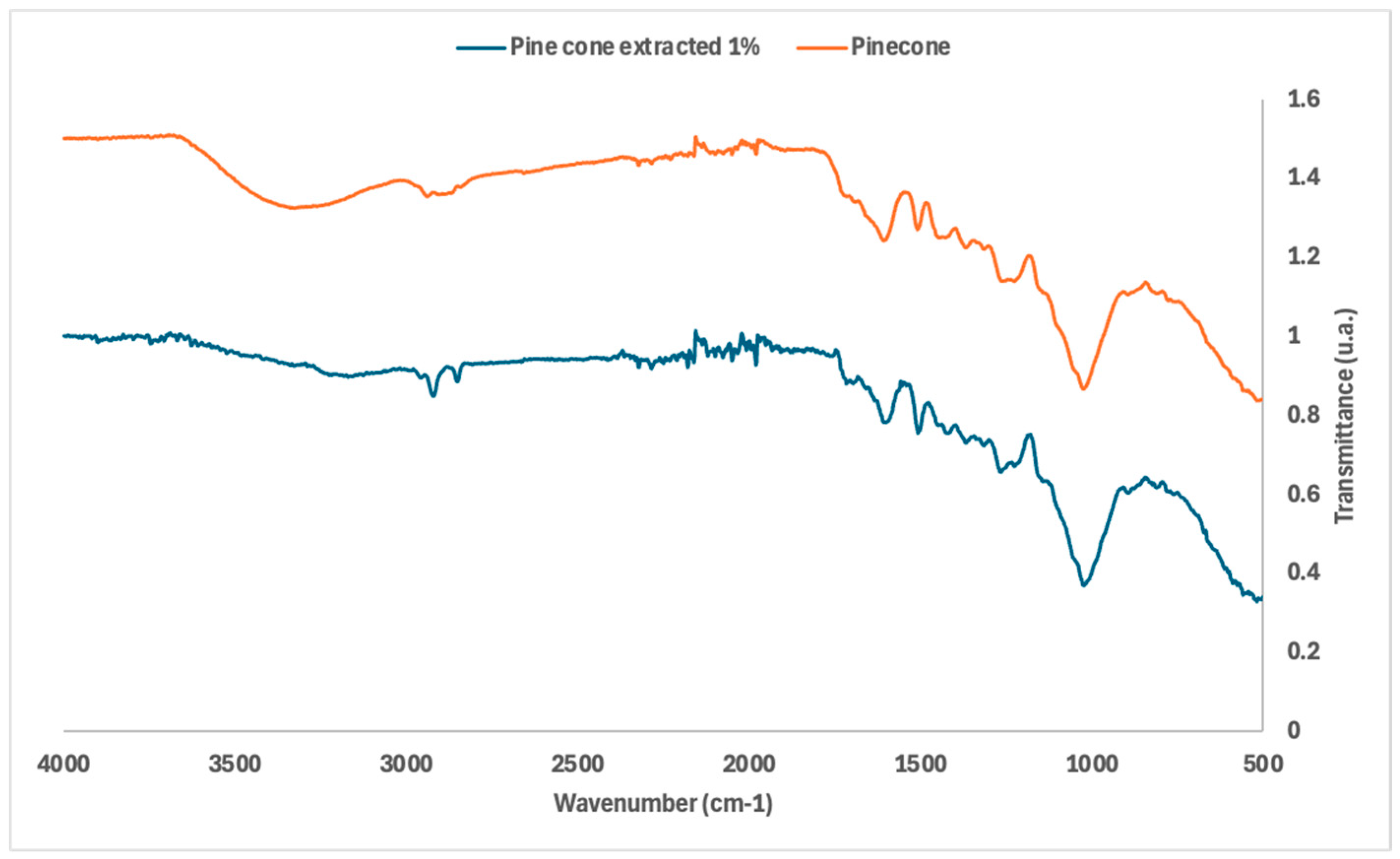
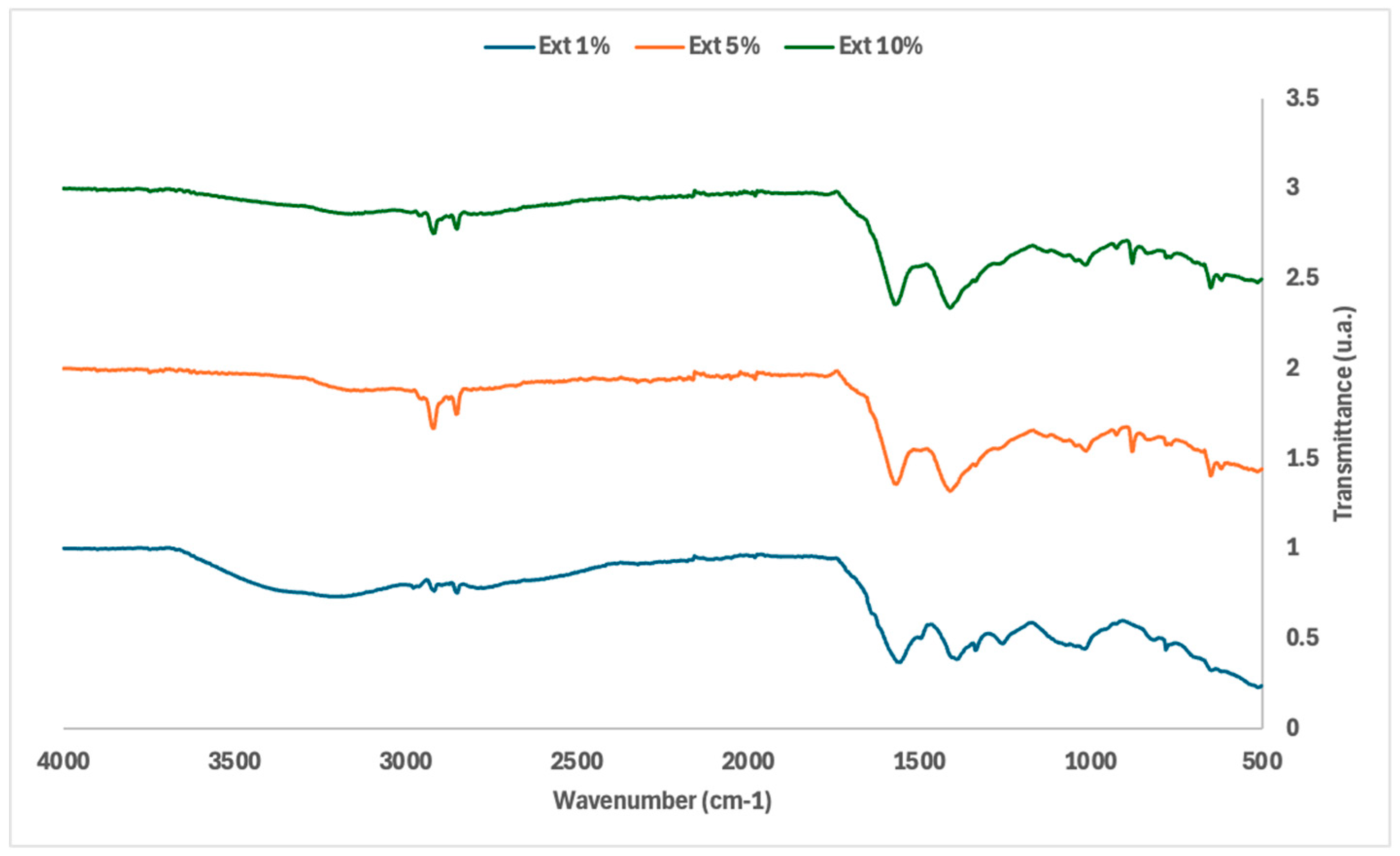


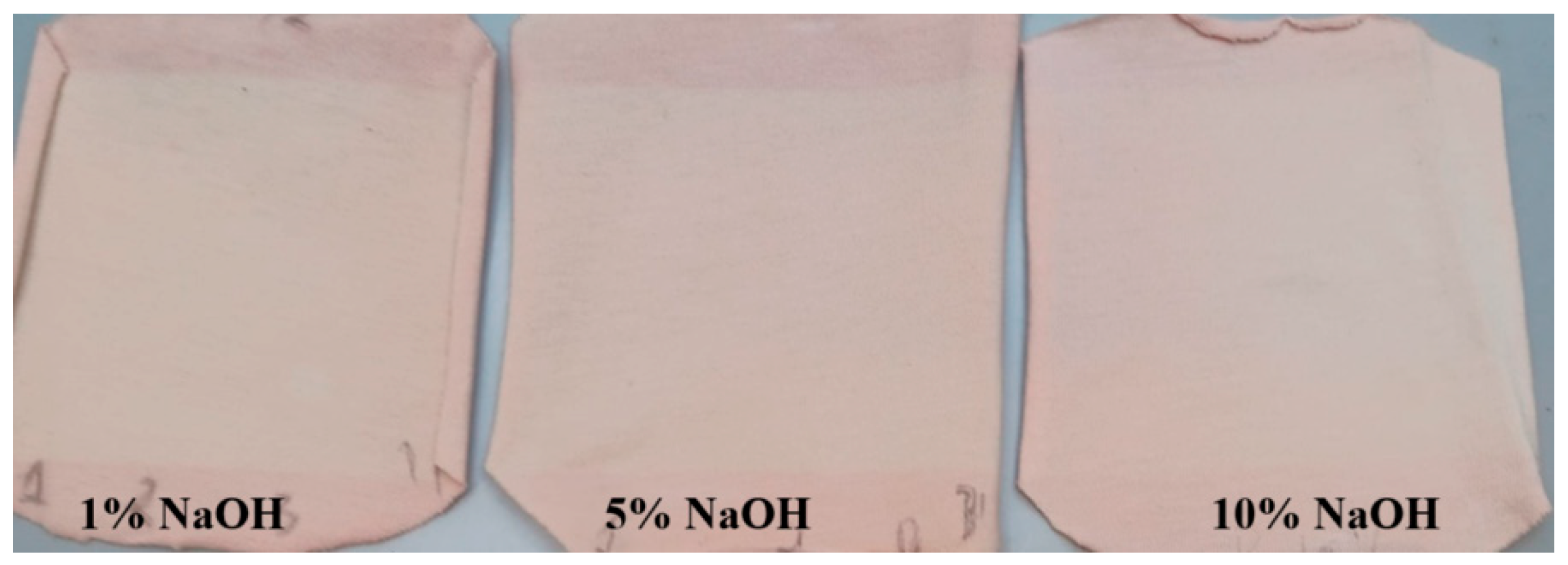
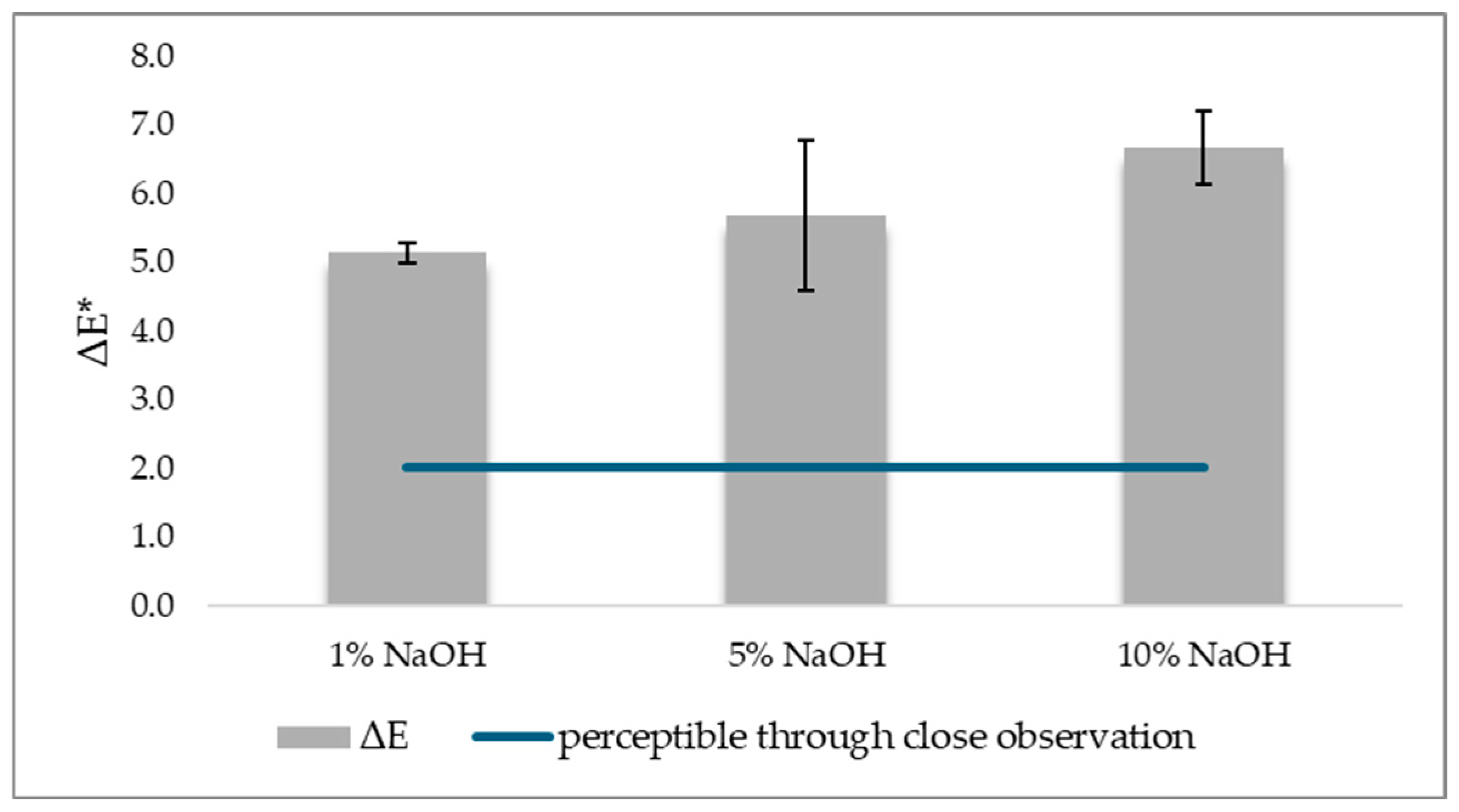
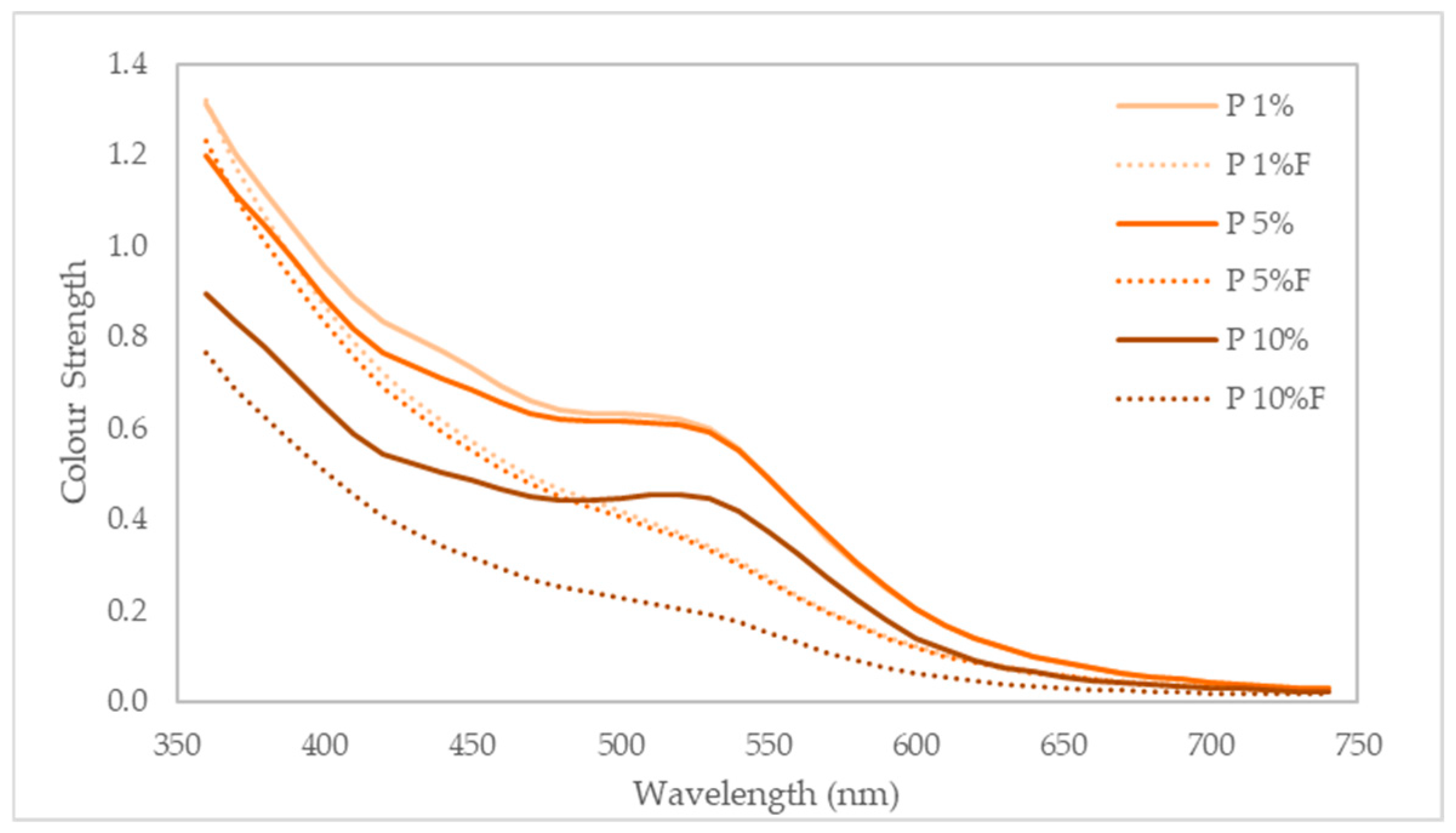

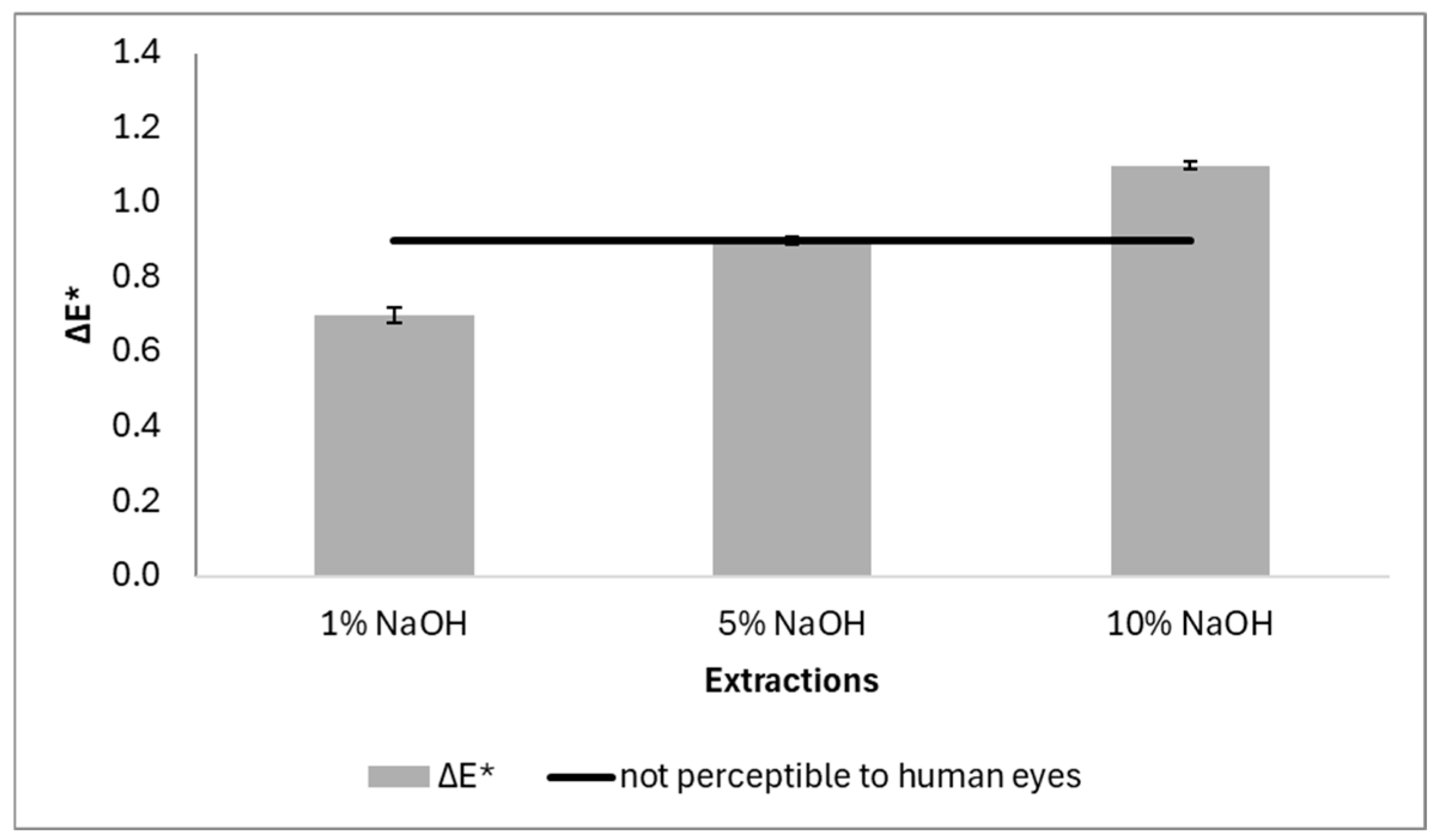
| Solvent Concentration (NaOH) | pH | Solids (%) | Phenols (%) | Antioxidant (%) | ||||
|---|---|---|---|---|---|---|---|---|
| M | SD | M | SD | M | SD | M | SD | |
| 1% | 9.9 | 0.01 | 1.0 | 0.01 | 2.3 | 1.2 | 23.2 | 0.2 |
| 5% | 12.3 | 0.01 | 1.2 | 0.01 | 12.1 | 0.5 | 11.7 | 0.2 |
| 10% | 12.8 | 0.01 | 1.6 | 0.01 | 9.4 | 0.4 | 10.3 | 0.01 |
| Dyeing | L* | a* | b* | |||
|---|---|---|---|---|---|---|
| M | SD | M | SD | M | SD | |
| 1% | 71.0 | 1.3 | 13.6 | 0.6 | 13.3 | 1.1 |
| 5% | 71.1 | 1.1 | 13.7 | 0.2 | 12.0 | 0.7 |
| 10% | 74.5 | 1.4 | 13.4 | 0.5 | 10.3 | 0.5 |
| Dyeing | ΔL* | Δa* | Δb* | ΔE* | ||||
|---|---|---|---|---|---|---|---|---|
| M | SD | M | SD | M | SD | M | SD | |
| 1% | 5.5 | 0.4 | −4.1 | 0.4 | 3.7 | 0.3 | 5.1 | 0.1 |
| 5% | 5.7 | 1.9 | −4.2 | 0.5 | 4.6 | 0.8 | 5.7 | 1.1 |
| 10% | 7.4 | 0.7 | −5.7 | 0.4 | 3.8 | 0.5 | 6.7 | 0.5 |
| Dyeing | ΔL* | Δa* | Δb* | ΔE* | ||||
|---|---|---|---|---|---|---|---|---|
| M | SD | M | SD | M | SD | M | SD | |
| 1% | 0.2 | 0.7 | −0.2 | 0.4 | 0.8 | 0.1 | 0.7 | 0.2 |
| 5% | 1.2 | 0.2 | −0.3 | 0.1 | 0.9 | 0.3 | 0.9 | 0.1 |
| 10% | 1.2 | 0.2 | −0.4 | 0.1 | 1.1 | 0.1 | 1.1 | 1.1 |
Disclaimer/Publisher’s Note: The statements, opinions and data contained in all publications are solely those of the individual author(s) and contributor(s) and not of MDPI and/or the editor(s). MDPI and/or the editor(s) disclaim responsibility for any injury to people or property resulting from any ideas, methods, instructions or products referred to in the content. |
© 2025 by the authors. Licensee MDPI, Basel, Switzerland. This article is an open access article distributed under the terms and conditions of the Creative Commons Attribution (CC BY) license (https://creativecommons.org/licenses/by/4.0/).
Share and Cite
Barreto, A.; Martins, J.M.; Ferreira, N.; Brás, I.; Carvalho, L.H. Valorisation of Forest Waste into Natural Textile Dyes—Case Study of Pine Cones. Forests 2025, 16, 769. https://doi.org/10.3390/f16050769
Barreto A, Martins JM, Ferreira N, Brás I, Carvalho LH. Valorisation of Forest Waste into Natural Textile Dyes—Case Study of Pine Cones. Forests. 2025; 16(5):769. https://doi.org/10.3390/f16050769
Chicago/Turabian StyleBarreto, Anna, Jorge M. Martins, Nuno Ferreira, Isabel Brás, and Luisa H. Carvalho. 2025. "Valorisation of Forest Waste into Natural Textile Dyes—Case Study of Pine Cones" Forests 16, no. 5: 769. https://doi.org/10.3390/f16050769
APA StyleBarreto, A., Martins, J. M., Ferreira, N., Brás, I., & Carvalho, L. H. (2025). Valorisation of Forest Waste into Natural Textile Dyes—Case Study of Pine Cones. Forests, 16(5), 769. https://doi.org/10.3390/f16050769






